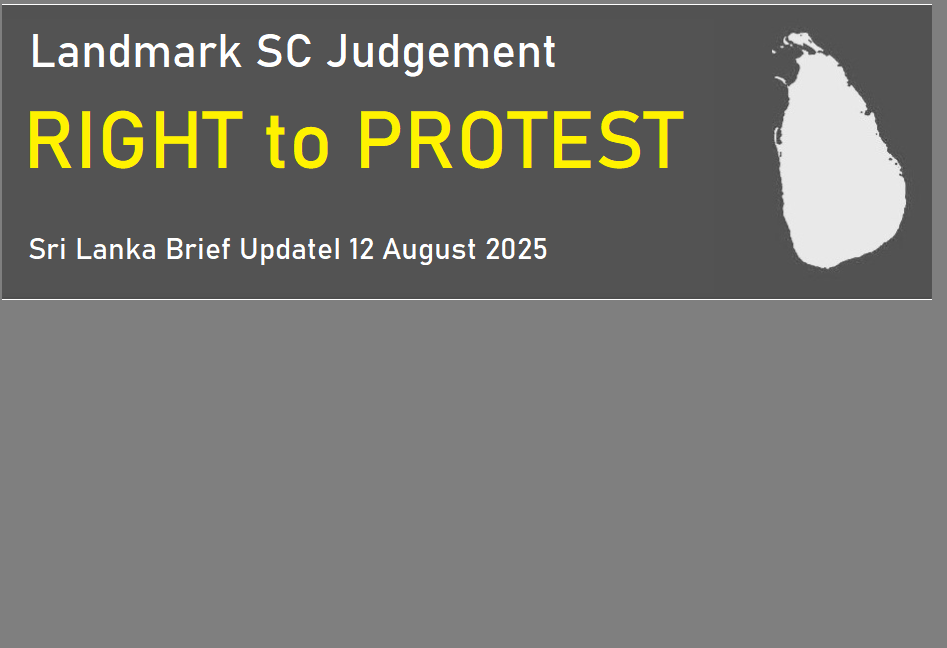Compiled by Sunanda Deshapriya.
- On 3rd July 2025 Sri Lanka Supreme Court delivered a landmark judgment (SC FR 346/2018) on Right to Protest. It addressed the arrest of two villagers following a protest in Kalukele, Polonnaruwa.
- Two villagers from Kalukele, Aralaganvila Polonnaruwa—rice farmers affected by wild elephant invasions filed a fundamental rights application at the Supreme Court their Right to Freedom Of Expression was violated by the police.
- On 6 June 2018, around 250 villagers of from Kalukele protested by blocking the Polonnaruwa–Mahiyanganaya road, demanding action from authorities. . Villagers faced repeated elephant attacks, resulting in deaths, crop destruction, and property damage. Authorities failed to maintain electric fences or respond to complaints. The protest was a desperate attempt to draw attention to their plight.
- On 18 June 2018, the petitioners were arrested for allegedly violating a Magistrate’s order and causing public nuisance
- The Court acknowledged the villagers’ right to protest but noted the complete road blockage constituted “public nuisance” and “wrongful restraint”.
- The Court held that the arrest was lawful under Section 32(1)(b) of the Criminal Procedure Code, as the petitioners were part of an unlawful assembly. But Court found the “remand custody was unlawful”, as the police report lacked legal justification and the Magistrate acted perfunctorily. “Magistrates should not act as mere rubber stamps” court affirmed.
- In its judgement Court’s maintained that protests are vital in a democracy and must be protected and Peaceful protests are lawful, but obstruction of public roads is not.
- Authorities must respond proportionally and lawfully—not with harassment or arbitrary detention. The Court cited precedents affirm the importance of dissent and the dangers of suppressing peaceful protest.
- Compensation of Rs. 30,000 awarded to each petitioner, payable by the Officer-in-Charge personally.
- The judgement called for practical solutions. It directs Attorney General to report on elephant conflict mitigation and protest-related reforms. Inspector General of Police to file compliance reports within 6 months on educating officers on lawful protest management. Judges’ Institute to initiate training modules on protest jurisprudence to train Magistrates on bail and remand procedures.
- The Supreme Court judgment offers a nuanced reflection on both “Gandhi-style peaceful resistance” and “Jinnah-style constitutional advocacy”, during the Indian independent struggle recognizing protest as a vital expression of democratic dissent.
- The Court frames Gandhi’s Peaceful Protest as Satyagraha and Civil Disobedience. The judgment acknowledges the moral and spiritual dimension of peaceful protest, echoing Gandhi’s philosophy: “Possibly influenced by Mahatma Gandhi’s style of peaceful activism, Sri Lanka has witnessed unique forms of protests, including Satyagrahas and candle-light vigils wherein spirituality is sought to be infused into peaceful protests associated with at times resistance and non-compliance which take the form of civil disobedience.
- This reflects the Court’s appreciation for nonviolent resistance as a legitimate and historically rooted form of expression.
- Ali Jinnah’s Legalistic Protest as Direct Action and Constitutional Dissent. The judgment refers more assertive forms of protest, akin to Jinnah’s “direct action”:“At the other end of the spectrum of protests is the Ali Jinnah style of protests with the call of ‘direct action’ wherein the demands of the protesters are to be achieved primarily by the protesters themselves, through action aimed at causing change.” This is an acknowledgement of the “strategic and political nature” of protest, especially when institutional channels fail.
- The Supreme Court’s Broader Philosophy on protest affirms protest as a composite fundamental right, combining freedom of speech, peaceful assembly, and association: “It can be said that the Constitution recognises de-facto a composite fundamental right to ‘demonstrate and protest and it emphasises that “Democracy without dissent is a delusion… it not only protects dissent, and tolerates it, but genuinely cherishes dissent.”
- Furthermore, the judgement warns against suppressing dissent: “Stifling the peaceful expression of legitimate dissent today can only result, inexorably, in the catastrophic explosion of violence some other day and insists that “use of force should be the last resort… Lethal force may be used only if… absolutely essential.”
- The Supreme Court insisted on the balance between protest and public order. While defending protest, the Court also emphasizes lawful conduct: “The use of a public space for a protest must be carried out in a lawful manner and not in a manner that violates the law of the land or impinge upon the rights of others.” This reflects a Jinnah-like respect for legal boundaries, even while asserting rights.
